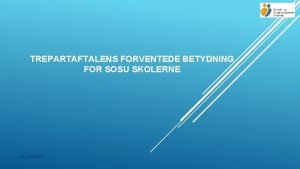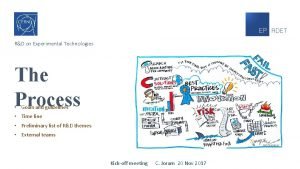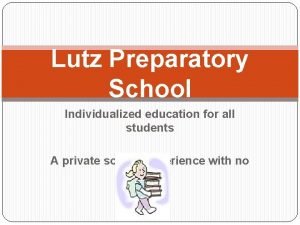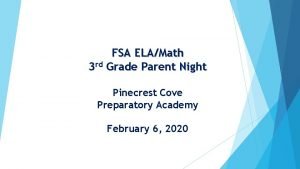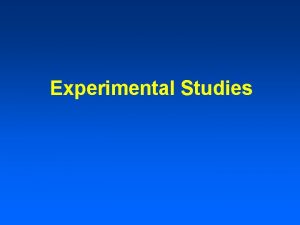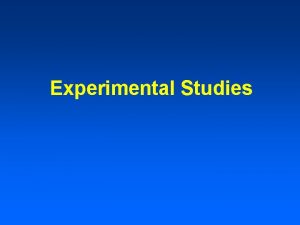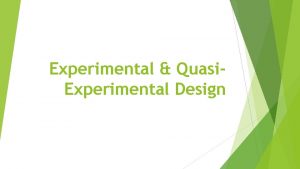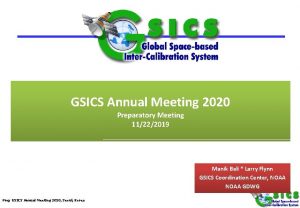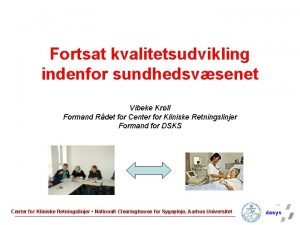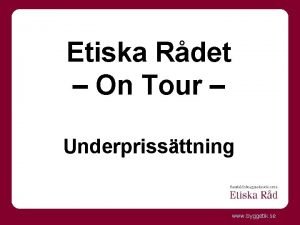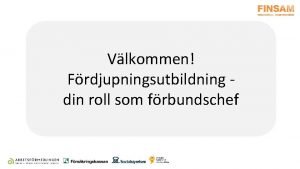RDET RD on Experimental Technologies Introduction Preparatory Meeting













- Slides: 13

RDET R&D on Experimental Technologies Introduction – Preparatory Meeting EP R&D WG 3 February 2018 Martin Aleksa & Carmelo D’Ambrosio (CERN) EP R&D Programme – Slides from C. Joram Scope of WG 3 “Calorimetry and Light Based Detectors” Our Roadmap What We Expect From You First Working Group Meeting on Feb. 27 February 27, 2018 M. Aleksa & C. D'Ambrosio (CERN) 1

RDET R&D on Experimental Technologies The Process • Goals and guidelines • Time line • Preliminary list of R&D themes • External teams Kick-off meeting C. Joram 20 Nov 2017 2

Our goals In one year from now we should … - have defined a convincing and ambitious R&D programme over 5 years, which covers the most relevant technologies for the years >2025. - break down in work packages - work plan with deliverables, milestones - resources needs (CHF and FTE) - risks, fall backs, alternatives - have written a comprehensive report, describing - context and motivation - state of the art - main challenges - proposed R&D (as above) - outlook on further future - some ideas on management & reporting 100+ pages ? Thi e. B reakthroughs n Partic le Phys i Ultimate cs EP e Detec xper tor ts 3

Some guidelines • Some R&D themes are very obvious, others require discussions and prioritising (the resources will be limited) • Process should be ‘bottom-up’ – you are the experts ! – but some steering is needed • Important: we don’t want to miss clever non-conventional ideas • We are defining an EP R&D programme, but we welcome and encourage the participation of external teams (see below) 4

The process Kick-off meeting SG nominates convenors of ‘obvious’ WG 16 March 2018 1 full day WG Conv. gather people and start to work R&D workshop I Open for external groups • • Proto-WGs and individuals present their views: state of the art, challenges and needs. present R&D ideas and proposals Discuss and finalise list of WGs WG meetings. Preparing their chapter. Early autumn 2018 1 -2 days R&D workshop II Open for external groups • • • WG present detailed plans Draft document available Harmonise work plan (common tasks, deliverables? ) Consolidation (resources) Final editing / polishing Release the document November 2018 5

(Current) list of work packages and convenors Working Groups Convenors Silicon detectors Heinz Pernegger, Luciano Musa, Petra Riedler, Dominik Dannheim Gas detectors Christoph Rembser, Eraldo Oliveri Calorimetry and light based detectors Martin Aleksa, Carmelo D'Ambrosio Detector Integration Corrado Gargiulo, Antti Onnela IC technologies Federico Faccio, Michael Campbell High Speed Links Paolo Moreira, Francois Vasey Software Graeme Stewart, Jakob Blomer Detector Magnets Herman Ten Kate, Benoit Cure 6

Topics proposed by steering group, (slightly updated after Kickoff meeting) Silicon Detectors: Integrated CMOS, LGAD, packaging and high density interconnect (chip-to-chip, waferto-wafer), tilable solutions Gas Detectors: Micro pattern detectors, solutions for large areas, fast detectors, environment friendly gases, technology transfer to industry Calorimetry & light based detectors: Radiation hard technologies, timing, scintillation, Cherenkov, photodetection Detector Integration: Low-mass structures, cooling, microfabrication, composite technologies, robotics, precision metrology and alignment IC Technologies: Hybrid pixel detectors, increased functionalities on chips, very deep submicron technologies, radiation hardness High speed Links: Radiation hardness, power dissipation, silicon photonics, wireless solutions Software for Experiments: New techniques for simulation and reconstruction, customizable turn-key systems, new HW/SW technologies Detector Magnets: Thin magnet technology We see potential for cooperation between the work packages. E. g. joint deliverables, common test beams, . . . 7

Mandate for Working Group (Co-)convenor(s) • The WG is formed by the convenors inviting specific persons (typically experts in a given domain) to contribute to the WG and by interested people joining the WG on their own initiative. • The convenors shall make sure that the WG covers all relevant expertise. Any person can contribute to the WG. There is no restriction on their prof. status (staff, user, …). • The WG composition shall reflect the landscape of technologies and experimental options. If required, the WG shall be organised in sub-groups. • The convenors shall set up a work plan for the period until workshop 1 (WS 1, date 16 March 2018). • The convenors shall organise meetings to discuss the scope of the WG, limitations, upcoming challenges, R&D lines, … If considered useful, a WG meeting can be held on the day before WS 1. • The convenors shall prepare a group session in WS 1 (approximately 45 minutes will be available for each WG). • For WS 2 (in autumn 2018), the convenors shall prepare a draft chapter of the R&D report, incl. concrete R&D lines, milestones, deliverables, resource estimates (approximately 10 -20 pages per WG). They can invite members of the WG to contribute to the editing process. 8

Collaboration of external teams • The program aims to support R&D activities in which EP teams play a major role. • These activities shall fit in the global context. Cooperation with external teams is welcome, often essential. • R&D collaborations, like RD 50 and RD 51, stimulate a huge resonance in the community, initiate and boost developments and foster communication and cooperation. They are LHCC reviewed. • We expect that certain tasks of the new R&D program will be carried out (by EP personnel) inside these R&D collaborations. External teams may join in and in this way strengthen our program. 9

Scope of WG 3 “Calorimetry and Light Based Detectors” • Two large areas: Calorimetry on the one hand light based detectors on the other hand (two areas often interconnected) • Calorimetry: – Which technologies could be suitable for future accelerator experiments (LHC beyond HL-LHC, FCC-ee, FCC-hh, CLIC, ILC, …)? • What are the challenges for calorimetry for future accelerator experiments? – Pile-up, radiation hardness, high resolution, particle ID, boosted objects, particle flow, timing…. • Active materials: Scintillating crystals, radiation tolerant scintillators, Si, noble liquids + ? Radiation hardness, low temperature operation, … – Which R&D exists in these areas? – Which R&D will be necessary to assure that future accelerator experiments can be built in O(20) years? • R&D on promising technologies • Including special focus on timing capabilities • Including R&D on engineering challenges (e. g. cryostats, feed-throughs, …) – We should propose a solid R&D plan in fall (can/should build on R&D carried out for HL-LHC) • Light based detectors: – – General detector concepts, (ex. vertexing and tracking with light, Cherenkov detectors, …); Scintillator materials (in- and organic, photonics, Cherenkov materials, …); Photodetection: vacuum, solid-state and gas based photodetectors; High Energy environment (high spatial and/or time resolutions, high rates/occupancies, rad. hardness, …). February 27, 2018 M. Aleksa & C. D'Ambrosio (CERN) 10

Our Roadmap… • First General WG 3 Meeting Today – Brainstorming session: Asked everybody who wants to participate to prepare 2 slides on present R&D projects at CERN in the field of WG 3, the needs of future accelerator experiments (beyond LHC Phase II upgrades) and ideas on R&D to make sure that these needs could be satisfied. – The agenda is very long – please stick to the 5 minutes presentation time!! – Allows us to collect information on current landscape and ideas for future • With your input from today we will then prepare our contribution (45’) to the 1 st R&D workshop on March 16. • After the 1 st workshop the goal is to consolidate and evaluate those R&D proposals – including additional information from experts, additional information from those presenting proposals (you), discussions with stake-holders (like detector groups of future accelerator experiments). – We have to make sure not to forget important topics (together with experts covering the full field) – If necessary we will define sub-areas of WG 3 and try to group R&D proposals – fully evaluate different proposals – Full working group meetings to report on the progress (probably also meetings in sub-groups). • Summer/Fall: Convergence to a proposal for the R&D report, incl. concrete R&D lines, milestones, deliverables, resource estimates • Platform for information exchange inside our WG 3: – EP-RDET-WG 3 -Cal-Light@cern. ch and – sharepoint area https: //espace. cern. ch/ep-rdet-wg 3 -cal-light/Site. Pages/Home. aspx (newsfeed and file upload) February 27, 2018 M. Aleksa & C. D'Ambrosio (CERN) 11

Thank You for Your Attention! … Time for your Questions … …Time for Discussion … February 27, 2018 M. Aleksa & C. D'Ambrosio (CERN) 12

Backup February 27, 2018 M. Aleksa & C. D'Ambrosio (CERN) 13
 Rdet
Rdet Rdet
Rdet Experimental vs non experimental
Experimental vs non experimental What are the 5 types of non experimental research design
What are the 5 types of non experimental research design Disadvantages of experimental research
Disadvantages of experimental research Experimental vs nonexperimental research
Experimental vs nonexperimental research Nonexperimental study
Nonexperimental study Today meeting or today's meeting
Today meeting or today's meeting Meeting objective
Meeting objective What is meeting and types of meeting
What is meeting and types of meeting What is meeting and types of meeting
What is meeting and types of meeting Young women's preparatory academy miami
Young women's preparatory academy miami Lutz prep lottery
Lutz prep lottery Ixl pinecrest cove
Ixl pinecrest cove
